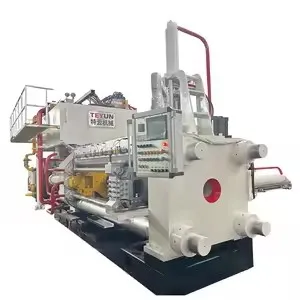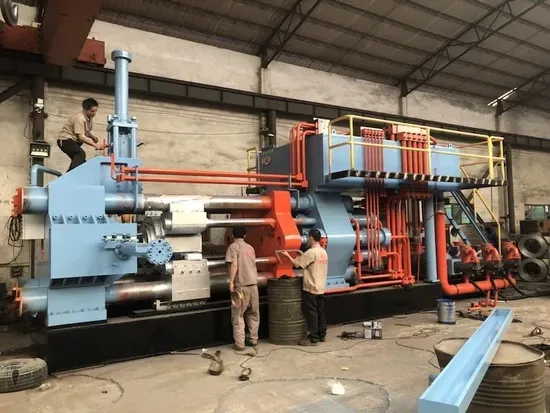Extrusion Press Loader: The Backbone of Modern Manufacturing
Extrusion press loaders represent a critical component in the metal forming and manufacturing industries, serving as the essential link between raw material handling and the extrusion process itself. These sophisticated material handling systems have revolutionized production efficiency, safety standards, and operational consistency in extrusion facilities worldwide.
Understanding Extrusion Press Loader Fundamentals
An extrusion press loader is an automated material handling system specifically designed to feed billets (typically aluminum, copper, or other non-ferrous metals) into extrusion presses. These systems have evolved from manual loading methods to highly sophisticated, computer-controlled automation solutions that optimize the entire extrusion workflow.
Core Components of Extrusion Press Loaders
Modern extrusion press loaders consist of several integrated subsystems that work in harmony to ensure seamless operation:
- Billet Storage and Handling System: Manages the storage and retrieval of billets from heating furnaces or storage racks
- Transfer Mechanism: Moves billets from storage to the press loading position
- Loading Arm/Mechanism: Precisely positions and inserts billets into the extrusion press container
- Control System: Computerized controls that coordinate all loader movements and synchronize with press operations
- Safety Systems: Integrated safety features including emergency stops, guards, and sensors
Types of Extrusion Press Loaders
The manufacturing industry employs various types of extrusion press loaders, each designed for specific production requirements and facility layouts.
Chain-Type Loaders
Chain-type loaders utilize continuous chain mechanisms to transport billets from heating furnaces to the press. These systems are known for their reliability and ability to handle high production volumes with consistent performance.
Walking Beam Loaders
Walking beam systems use a lifting and transferring motion to move billets through the loading sequence. This design minimizes billet surface damage and provides precise positioning control.
Robot-Based Loaders
Advanced robotic loaders offer maximum flexibility in billet handling, capable of adapting to various billet sizes and shapes without mechanical adjustments. These systems are increasingly popular in facilities requiring frequent product changeovers.
 Robotic extrusion press loader handling aluminum billets with precision
Robotic extrusion press loader handling aluminum billets with precision
Key Performance Metrics and Specifications
Understanding the critical specifications of extrusion press loaders helps manufacturers select the appropriate system for their operational needs.
| Parameter | Standard Range | Importance |
|---|---|---|
| Loading Capacity | 100-10,000 kg/hour | Determines production throughput |
| Billet Diameter Range | 50-500 mm | Defines product flexibility |
| Billet Length Range | 300-2,000 mm | Affects material utilization |
| Loading Cycle Time | 5-30 seconds | Impacts overall press efficiency |
| Positioning Accuracy | ±1-5 mm | Critical for product quality |
Advanced Features in Modern Extrusion Press Loaders
Contemporary extrusion press loaders incorporate numerous advanced features that enhance performance, reliability, and operational intelligence.
Integrated Temperature Monitoring
Advanced thermal imaging systems monitor billet temperatures throughout the loading process, ensuring optimal extrusion conditions and preventing quality issues caused by temperature variations.
Predictive Maintenance Systems
Modern loaders employ IoT sensors and AI algorithms to predict maintenance needs, reducing unexpected downtime and extending equipment lifespan through proactive servicing.
Adaptive Control Algorithms
Sophisticated control systems automatically adjust loading parameters based on billet characteristics, press conditions, and production requirements, optimizing performance without manual intervention.
 Control panel and monitoring system for extrusion press loader operations
Control panel and monitoring system for extrusion press loader operations
Economic Impact and Return on Investment
The implementation of automated extrusion press loaders delivers substantial economic benefits that justify the capital investment through multiple operational improvements.
| Benefit Category | Typical Improvement | Financial Impact |
|---|---|---|
| Labor Efficiency | 60-80% reduction in manual handling | Lower labor costs, reduced ergonomic issues |
| Production Uptime | 15-25% increase | Higher asset utilization, more output |
| Material Waste Reduction | 3-8% improvement | Lower material costs, better yield |
| Quality Consistency | 40-60% fewer defects | Reduced scrap, higher customer satisfaction |
| Energy Efficiency | 10-20% improvement | Lower utility costs, sustainability benefits |
Safety Considerations and Compliance
Extrusion press loaders incorporate comprehensive safety systems that protect both personnel and equipment while ensuring compliance with international manufacturing safety standards.
Essential Safety Features
- Emergency stop systems with redundant activation points
- Light curtains and presence detection sensors
- Interlocked guarding systems
- Automatic fault detection and shutdown protocols
- Regular safety system validation and testing
 Safety systems and guarding on industrial extrusion press loader
Safety systems and guarding on industrial extrusion press loader
Future Trends in Extrusion Press Loader Technology
The evolution of extrusion press loaders continues with emerging technologies that promise even greater efficiency, flexibility, and intelligence.
Artificial Intelligence Integration
AI-powered loaders can learn from production patterns, optimize loading sequences in real-time, and automatically adjust to varying material properties and production demands.
Digital Twin Technology
Virtual replicas of loader systems enable simulation, optimization, and predictive maintenance without disrupting actual production operations.
Sustainable Design Innovations
Next-generation loaders focus on energy recovery systems, reduced environmental impact, and compatibility with recycled materials to support circular economy initiatives.
Selection Criteria for Extrusion Press Loaders
Choosing the right extrusion press loader requires careful consideration of multiple factors to ensure optimal performance and return on investment.
- Production Volume: Match loader capacity to current and anticipated production requirements
- Material Characteristics: Consider billet size, weight, temperature, and material type
- Facility Constraints: Evaluate available space, layout, and integration with existing equipment
- Automation Level: Determine the appropriate balance between automation and operational flexibility
- Maintenance Requirements: Assess service needs, parts availability, and technical support
 Custom extrusion press loader installation in manufacturing plant
Custom extrusion press loader installation in manufacturing plant
Conclusion: The Strategic Importance of Extrusion Press Loaders
Extrusion press loaders have transformed from simple material handling devices to sophisticated, intelligent systems that form the backbone of modern extrusion operations. Their continuous evolution drives manufacturing efficiency, product quality, and competitive advantage in global markets. As technology advances, these systems will continue to play a pivotal role in shaping the future of metal forming and manufacturing industries worldwide.

